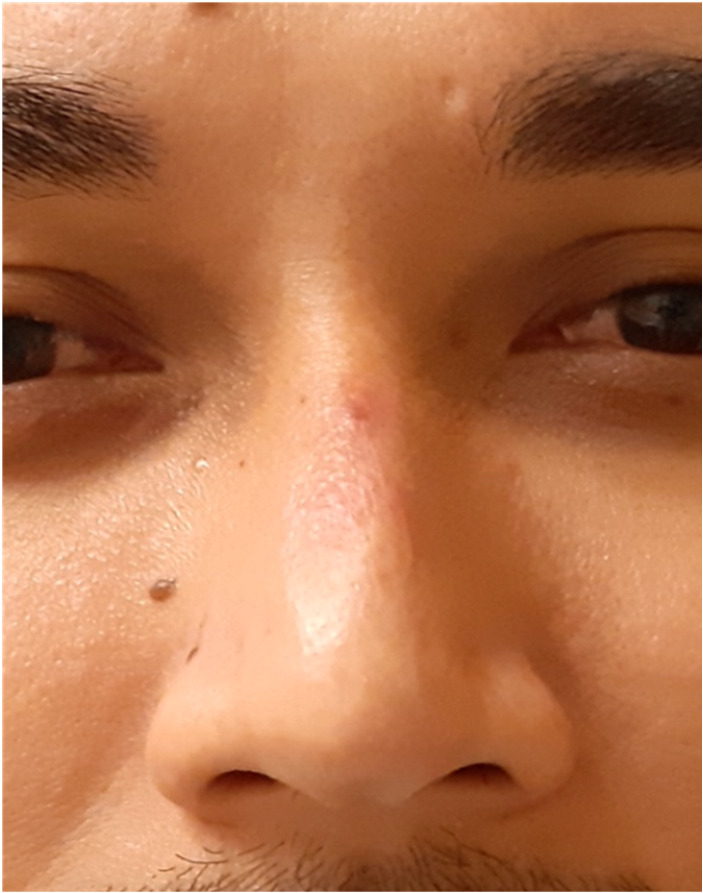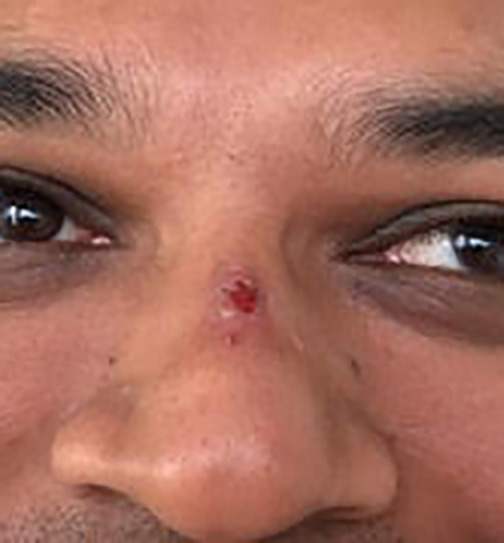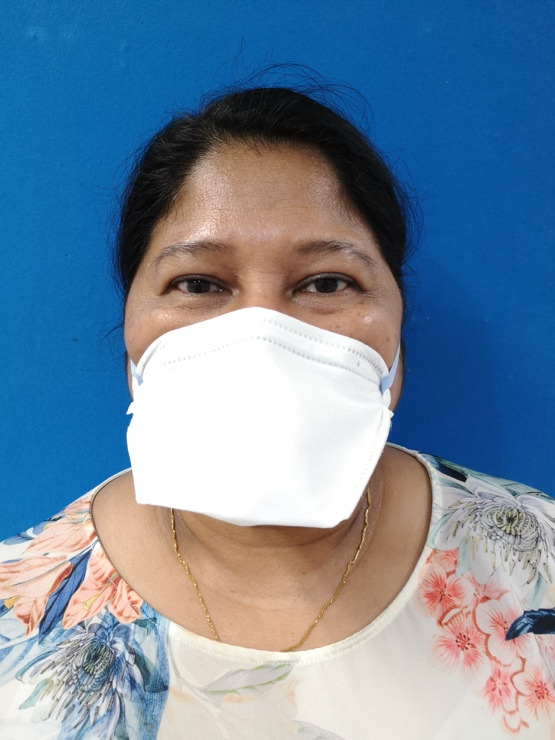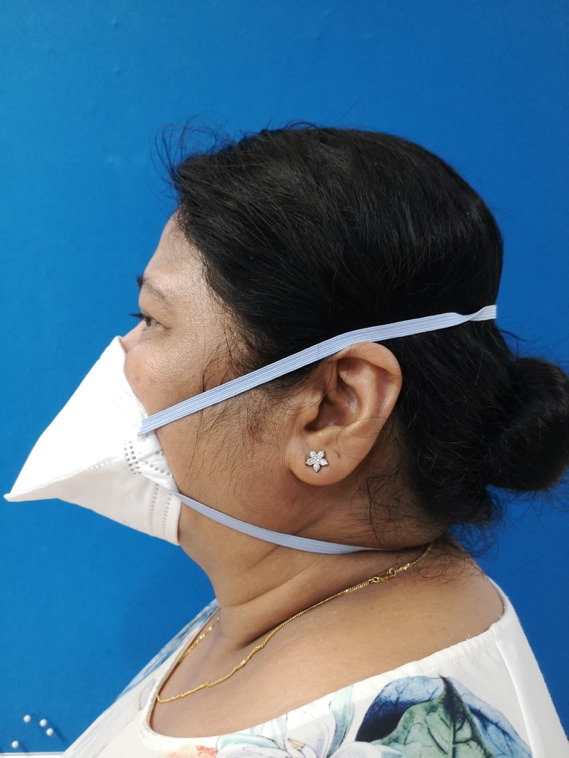1.
Dear Editors,
1. COVID‐19 CASES
The protection efficacy of facemasks and respirators has been well documented. The N95 respirator is essential amongst health care workers (HCW) treating COVID‐19 patients. Pressure ulcers over the bony prominences of the face have been heavily reported with the usage of non‐invasive ventilation face mask. However, pressure ulcers over the dorsum of the nose associated with the usage of N95 respirators have not yet been reported. The duration and proper application of the N95 respirator are essential and should be conveyed to each HCW in order to prevent this morbidity.
2. N95 RESPIRATOR ASSOCIATED PRESSURE ULCER AMONGST COVID‐19 HCW
The severe acute respiratory syndrome coronavirus 2 (SARS‐CoV‐2) was first reported in Wuhan, Hubei Province of China in December 2019. World Health Organization soon declared it a worldwide pandemic. 1 The spread of the disease was soon identified as droplet contact. Hence facemasks and respirators are important components of personal protective equipment for HCW. The protection efficacy of facemasks and respirators is of importance as they filter fine airborne particles from reaching the respiratory system and thus prevent inter‐human infection. It was generally accepted that N95 respirator is more effective for filtration compared to facemask. 2
A pressure injury is localised damage to the skin and underlying soft tissue, usually over a bony prominence. It occurs as a result of intense or prolonged pressure or pressure in combination with shear. It can present as an intact skin with erythema or an open ulcer and painful. 3
The usage of N95 respirator is recommended during aerosol‐generating medical procedures performed on suspected or confirmed COVID‐19 patients. 4 The long term physiological effect of the N95 has been previously described. 2 However, there has not been any report of nasal bridge pressure ulcers associated with the N95 respirator. We describe a series of five HCW who presented to us with nasal pressure ulcers within a span of 2 weeks. This HCW were all involved in treating COVID‐19 positive patients in the Intensive Care Unit (ICU) at a designated COVID‐19 Hospital. This sudden surge in the number of HCW developing pressure ulcers in such a short duration is both alarming and worrying.
Hospital Sungai Buloh is tasked with the duty of being the designated COVID‐19 Hospital on the 25th of January 2020 with a total of 2069 beds.
We describe a series of five HCW who are serving in our ICU during this COVID‐19 outbreak (Table 1). They presented with pressure ulcers over the dorsum of the nose following prolonged usage of the N95 respirator. Four cases were of grade 1 pressure ulcer (Figure 1) while one recorded a grade 3 pressure ulcer (Figure 2). On average, the N95 respirator (Figure 3 and 4) was used over 5 hours after each donning procedure. Although the N95 respirator has been introduced and used in the medical field since the 70s, this is the first study to describe pressure ulcers over the dorsum of the nose associated with its usage.
TABLE 1.
Case presentation to plastic surgery clinic within 2 weeks duration
| Location | Age | Pressure sore | Duration of continuous usage/d | Type of mask | Treatment |
|---|---|---|---|---|---|
| ICU | 35 y |
Dorsum of the nose NPUAP a Grade 3 |
6‐7 h |
Pasture F550CS |
BETAplast |
| ICU | 29 y |
Dorsum of the nose NPUAP a Grade 1 |
4‐5 h |
Pasture F550CS |
DuoDERM Extra thin |
| ICU | 34 y |
Dorsum of the nose NPUAP a Grade 1 |
4‐5 h |
Pasture F550CS |
DuoDERM Extra thin |
| ICU | 36 y |
Dorsum of the nose NPUAP a Grade 1 |
3 h |
Pasture F550CS |
DuoDERM Extra thin |
| ICU | 30 y |
Dorsum of the nose NPUAP a Grade 1 |
7 h |
Pasture F550CS |
DuoDERM Extra thin |
Grading for pressure ulcer based on NPUAP (National Pressure Ulcer Advisory Panel). 3
FIGURE 1.

Grade 1 pressure injury
FIGURE 2.

Grade 3 pressure injury
FIGURE 3.

N95 respirator (Pasture F550 CS) AP view
FIGURE 4.

N95 respirator (Pasture F550 CS) lateral view
Upon interviewing each HCW, it is clear that the fear of contracting the COVID‐19 has led to HCW securing the N95 respirator tighter than required. Each of them has explicitly expressed a high level of anxiety and fear while attending to these COVID‐19 patients who remain intubated in the ICU. Hence the tighter the N95 respirator was secured, the more comfort and support it provided the HCW mentally. This did not directly correlate to the efficacy of the N95 respirator.
The recommended method was to use both hands to bend the nosepiece to fit snugly against the nose and face. Then slide fingers down both sides of the nosepiece to seal it against the nose and face. HCW's are advised not to push the respirator against the face. A seal test is done by the HCW to ensure proper fit of the N95 respirator. 5 , 6
As the world is currently facing this pandemic together, countries are expectantly running low on personal protective equipment such as N95 respirators. This then propagates new guidelines on extended use and limited re‐use of N95 respirators to tide us over this pandemic. 7 , 8 , 9 , 10 All our HCW use their N95 for prolonged durations. This is to ensure they do not exhaust the limited supply of N95 respirators that are available.
To overcome these issues, we advocate proper personal protective equipment training. This is carried out by our Occupational and Safety Health department who provides the training, which includes proper donning and doffing of N95 respirator. This training and re‐training are done on a regular basis for all HCW prior to serving in the COVID‐19 wards. This will reinforce the proper use of the N95 respirator and address the insecurities experienced by HCW. As for HCW who have developed the pressure ulcers, we introduced the use of a barrier dressing, DuoDERM Extra Thin. This dressing was selected predominantly because of its physical property. It is strong, yet thin enough to allow a good seal during donning of the N95 respirator.
We further advised HCW to apply prophylactic barrier creams 30 minutes prior to donning as this has proven efficacy against developing a pressure ulcer. 11 We also advocate the usage of barrier dressing as prophylaxis. Together with this, we advise HCW to relieve the pressure of their N95 respirators every 2 hours. 11
In summary, the proper usage of the N95 respirator as a protective device among HCW could be achieved with adequate training and compliance with the recognised guidelines for its usage.
REFERENCE
- 1. Coronavirus disease (COVID‐2019) situation reports. Geneva: World Health Organization, 2020. https://www.who.int/emergencies/diseases/novel-coronavirus-2019/situation-reports/.opensinnewtab. [Google Scholar]
- 2. Zhu JH, Lee SJ, Wang DY, et al. Effects of long‐duration wearing of N95 respirator and surgical facemask: a pilot study. J Lung Pulm Respir Res. 2014;1(4):97‐100. 10.15406/jlprr.2014.01.00021. [DOI] [Google Scholar]
- 3. Edsberg LE, Black JM, Goldberg M, McNichol L, Moore L, Sieggreen M. Revised National Pressure Ulcer Advisory Panel pressure injury staging system: revised pressure injury staging system. J Wound Ostomy Continence Nurs. 2016;43(6):585‐597. [DOI] [PMC free article] [PubMed] [Google Scholar]
- 4.Malaysian Ministry of Health, Guidelines COVID‐19 Management No.5/2020 Updated On March 24, 2020.
- 5. NIOSH (2010). How to properly put on and take off a disposable respirator. U.S. Department of Health and Human Services, Centers for Disease Control and Prevention, National Insitute for Occupational Safety and Health, DHHS (NIOSH) Publication No. 2010‐133. https://www.cdc.gov/niosh/docs/2010-133/pdfs/2010-133.pdf. [Google Scholar]
- 6. Viscusi DJ, Bergman MS, Zhuang Z, Shaffer RE. Evaluation of the benefits of the user seal check on N95 filtering facepiece respirator fit. J Occup and Evironl Hyg. 2012;9(6):408‐416. [DOI] [PubMed] [Google Scholar]
- 7. https://www.hopkinsmedicine.org/geriatric_medicine_gerontology/_downloads/readings/section8.pdf.
- 8. http://www.accessdata.fda.gov/scripts/cdrh/cfdocs/cfPMN/pmn.cfmexternalicon; 2014.
- 9. Murray M, Grant J, Bryce E, Chilton P, Forrester L. Facial protective equipment, personnel, and pandemics: impact of the pandemic (H1N1) 2009 virus on personnel and use of facial protective equipment. Infect Control Hosp Epidemiol. 2010;31(10):1011‐1016. [DOI] [PubMed] [Google Scholar]
- 10. Beckman S, Materna B, Goldmacher S, et al. Evaluation of respiratory protection programs and practices in California hospitals during the 2009‐2010 H1N1 influenza pandemic. Am J Infect Control. 2013;41(11):1024‐1031. [DOI] [PMC free article] [PubMed] [Google Scholar]
- 11. Gefen A, Alves P, Ciprandi G, et al. Device related pressure ulcers: SECURE prevention. J Wound Care. 2020;29(suppl 2a):S1–S52. 10.12968/jowc.2020.29.Sup2a.S1. [DOI] [PubMed] [Google Scholar]


